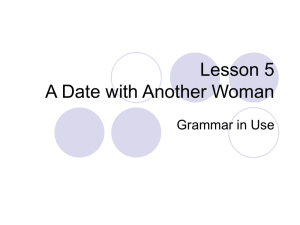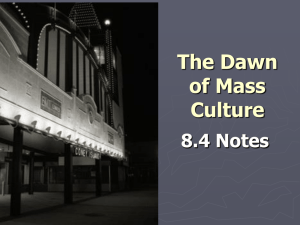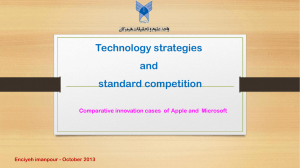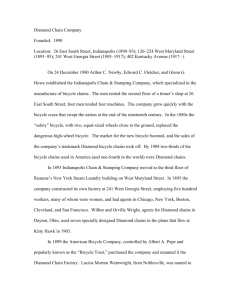Using MIS 2e Chapter 3: Information Systems for Competitive
advertisement
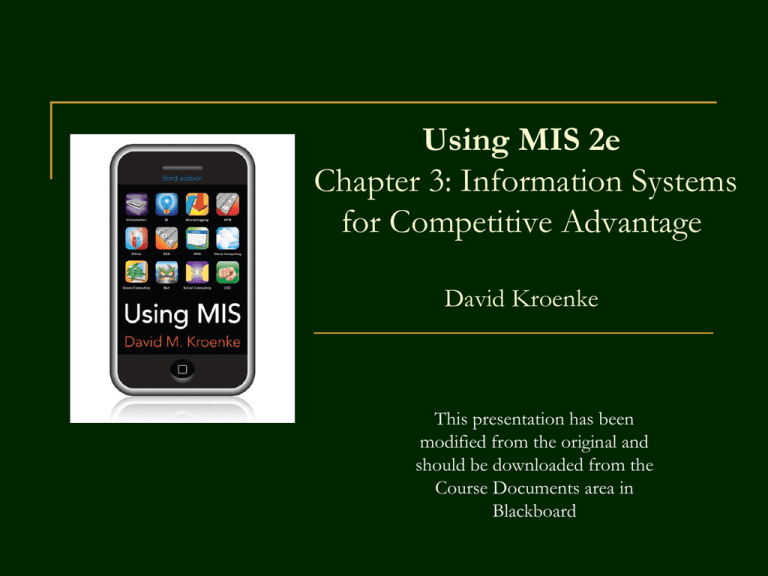
Using MIS 2e Chapter 3: Information Systems for Competitive Advantage David Kroenke This presentation has been modified from the original and should be downloaded from the Course Documents area in Blackboard Study Questions Q1 – How does organizational strategy determine information systems structure? Q2 – What five forces determine industry structure? Q3 – What is competitive strategy? Q4 – What is a value chain? Q5 – How do business processes generate value? Q6 – How does competitive strategy determine business processes and the structure of information systems? Q7 – How do information systems provide competitive advantages? Ethics Guide – The Digital Divide Chapter 3: Information Systems for Competitive Advantage 3-2 Q1 – How does organizational strategy determine IS structure? Michael Porter developed three different models (industry structure, competitive strategy, and value chains) that laid the groundwork to create integrated, cross-departmental business systems. As can be seen, the structure of an industry determines an organization’s competitive strategy, giving rise to value chains and business processes, which results in the structure of the information system. Chapter 3: Information Systems for Competitive Advantage 3-3 Q2 – What Five Forces Determine Industry Structure? The threat of threat of a new vendor is weak for an NFL franchise; the force is very strong if you are the corner latte stand The bargaining power of customers is a strong force if you are an appliance company selling to WalMart; it is weak if you are an oil company selling gas to consumers The rivalry among existing firms is a strong force for used car dealers in a city or town; it is weak (nonexistent) if you are the IRS The bargaining power of suppliers is a strong force for a PC manufacturer dealing with Microsoft; it is a weak force for bread manufacturers dealing with grain farmers in a surplus year The threat of substitutions is strong for an auto-rental company catering to frequent travelers; the force is very weak for a drug company with a patent on the only effective drug for a specific disease Porter’s five forces model determines industry profitability. Organizations examine the effects of these forces and their relative strength to arrive at a competitive strategy. The forces may be strong or weak. Chapter 3: Information Systems for Competitive Advantage 3-4 Q3 – What is Competitive Strategy? Walmart provides the lowest cost in the retail industry Lexus competes on how its products are better and more luxurious across the industry Southwest Airlines is the cost leader for certain portions of the airline industry Apple’s iPhone competes by being different from other cell phones A company can choose one of four competitive strategies to help it respond to the structure of its industry. Chapter 3: Information Systems for Competitive Advantage 3-5 Q4 – What is a Value Chain? A value chain is a network of activity within an organization that implements the business strategy. Each stage of the primary chain accumulates costs and adds value. Margin is the difference between cost and value. Support activities enable the primary activities to take place Chapter 3: Information Systems for Competitive Advantage 3-6 Q4 – What is a Value Chain (Primary and Support Activities)? Primary Activities are functional areas in the organization that process inputs and produce outputs. Inbound Logistics – receiving and stocking of raw materials and parts Operations/Manufacturing – processing orders and raw materials into finished product Outbound Logistics – distribution of the finished product to customers Marketing and Sales – creating demand for the product (pre-sale) Customer Service –Product or customer support (post-sale) Support Activities contribute indirectly to the production, sale, and service and enable the primary activities to take place: Infrastructure – hardware and software to support primary activities Human Resources – employee management (hiring, interview scheduling, and benefits management) Technology Development – the design and development of applications that support the organization Procurement – purchase of goods or services that are required as inputs to primary activities Chapter 3: Information Systems for Competitive Advantage 3-7 Q4 – What is a Value Chain; e.g., Bicycle Manufacturer? Each stage of the primary chain accumulates costs and adds value. Margin is the difference between cost and value. Each activity chain links to other activities in the chain. Linkages are the interactions across the value activities. Understanding a company’s linkages helps it succeed in designing or redesigning its business processes. Chapter 3: Information Systems for Competitive Advantage 3-8 Q5 – How Do Business Processes Generate Value? A business process is a network of activities that generate value by transforming inputs into outputs. The various activities access different databases determine the information system. Chapter 3: Information Systems for Competitive Advantage 3-9 Q5 – How Do Business Processes Generate Value? The purchase-bicycleparts activity has been redesigned to query the finished goods inventory to include information about customer demand in the ordering decision for raw materials. Linkages are interactions across value activities; e.g., manufacturing systems use linkages to reduce inventory by using sales forecasts to plan production, then use production to plan raw materials. Understanding a company’s linkages helps it succeed in designing or redesigning its business process. Chapter 3: Information Systems for Competitive Advantage 3-10 Q5 – How Do Business Processes Generate Value? Each network of activity transforms input resources into output resources; i.e., bicycle parts are transformed into a bicycle through a network of activities, both primary and support. You determine the cost of each business process by adding the cost of inputs plus the cost of activities used in the process. You determine the margin of each business process by subtracting the cost of the activity from the value of the output. A company’s resources, like inventory parts, equipment, or cash, flow between or among all the activities used to produce a product. The key to a company’s competitive advantage is to increase the margin of its products by adding value, reducing costs, or both. Business process redesign helps a business streamline its activities in order to increase its margins by creating more efficient processes. The most difficult part of process redesign is associated with employee resistance. Chapter 3: Information Systems for Competitive Advantage 3-11 Q6 – How Does Competitive Strategy Determine Business Processes and Structure of Information Systems? A business must first analyze its industry and choose a competitive strategy. Then it must design its business processes to span valuegenerating activities. After those decisions have been made, the business can structure an IS that supports its business processes. Consider two bicycle rental companies, one with a strategy of lowcost rentals to students versus one that seeks “best of breed” to executives at a high end conference resort Chapter 3: Information Systems for Competitive Advantage 3-12 Q6 – How Does Competitive Strategy Determine Business Processes and Structure of Information Systems? The competitive strategy determines the eventual information system. The student rental business can use a “shoebox” for its data facility. The high-service business however makes extensive use of information systems including a CRM to monitor past customer rental activity as well as an inventory database to “up sell” bicycle rentals as well as to control bicycle inventory so as not to disrupt customers Chapter 3: Information Systems for Competitive Advantage 3-13 Q6 – How Does Competitive Strategy Determine Business Processes and Structure of Information Systems? Fig 3-10 Business Process & Information System for Bike Rental Chapter 3: Information Systems for Competitive Advantage 3-14 Q7 – How Do Information Systems Provide Competitive Advantages? Information systems enable a business to gain competitive advantage via their products and services and/or by developing superior business processes. A business can gain a competitive advantage via its products by: Creating new products and services, or Enhancing its existing products or services, or Differentiating its products and services from its competitors Information systems can help create a competitive advantage by being part of the product or by providing support to the product. A company can also gain a competitive advantage by using business processes to Lock in customers via high switching costs Lock in suppliers via easy-to-use connections Create entry barriers for new competitors; e.g., patents. Establish alliances with other organizations Set industry standards Chapter 3: Information Systems for Competitive Advantage 3-15 Ethics Guide – The Digital Divide Money and information grow exponentially The more money you have, the easier it is to make more money (5% on $10 million earns $500,000; 5% on $10,000 earns $500) The more knowledge you have the easier it is to acquire additional knowledge Every year the disparity increases; the “have-nots” stand still, whereas the “haves” pull further ahead The Digital Divide refers to the gap between those with access to the Internet compared to those without (e.g., the poor, the elderly, and the poorly educated) The digital divide also exists outside the US. What does this mean for these countries’ ability to compete? What should be done for those without Internet access? What is the role of government? One Laptop Per Child - www.laptop.org (Nicholas Negroponte) Chapter 3: Information Systems for Competitive Advantage 3-16 Summary Michael Porter developed three different models (industry structure, competitive strategy, and value chains) that laid the groundwork to create integrated, cross-departmental business systems. The structure of an industry determines an organization’s competitive strategy, giving rise to value chains and business processes, resulting in the structure of an information system. A value chain is a network of activity within an organization that implements the business strategy. The value chain is comprised of primary activities and support activities. A business process is a network of activities that generate value by transforming inputs into outputs. Information systems enable a business to gain competitive advantage via their products and services and/or by developing superior business processes. The digital divide refers to the gap between those with access to the Internet compared to those without (e.g., the poor, the elderly, and the poorly educated) Chapter 3: Information Systems for Competitive Advantage 3-17 Review: Select the appropriate term for each item Michael Porter – Value Chain – Business Process – Primary Activity Five Forces Model – Linkage – Secondary Activity – Digital Divide 1. 2. 3. 4. 5. 6. 7. 8. Infrastructure and Human Resources are considered as this type of activity within the value chain. Secondary Activity Inbound and Outbound logistics are considered as this type of activity within the value chain. Primary Activity He defined the value chain and also developed a model of competitive strategies. Michael Porter Term that distinguishes those that have Internet Access from those who do not. Digital Divide Network of activities that generate value by transforming inputs into outputs. Business Process Interaction across value activities Linkage Determines industry structure and profitability Five Forces Model Network of activity that implements the business strategy Value Chain Chapter 3: Information Systems for Competitive Advantage 3-18




